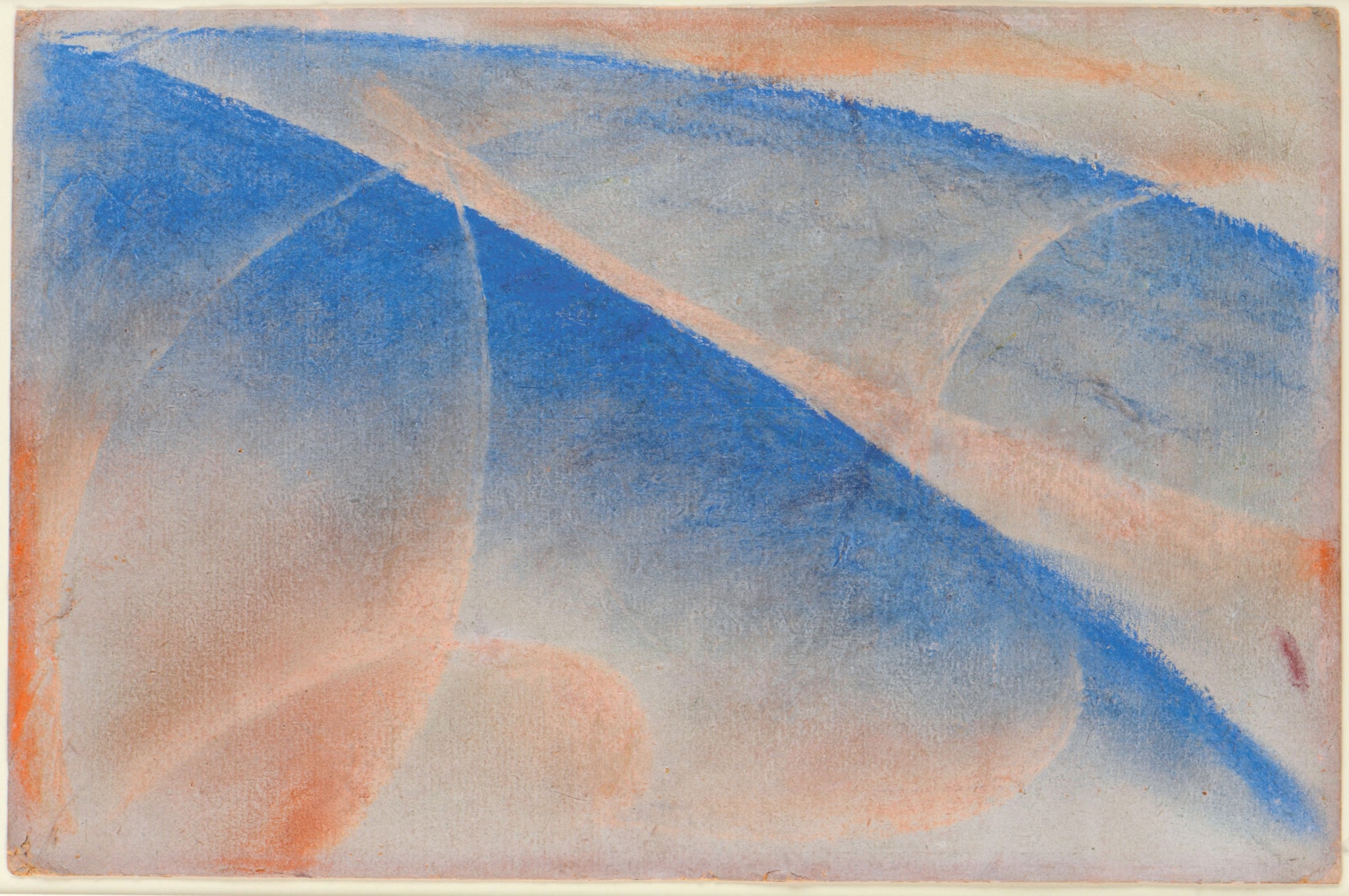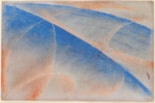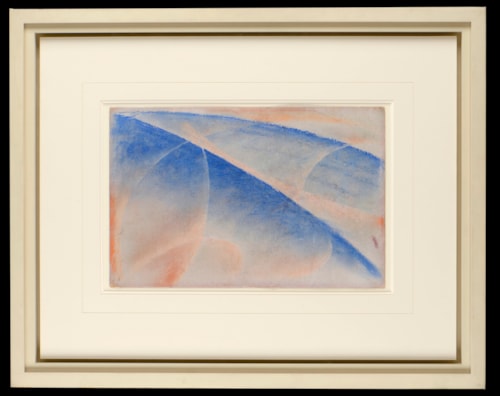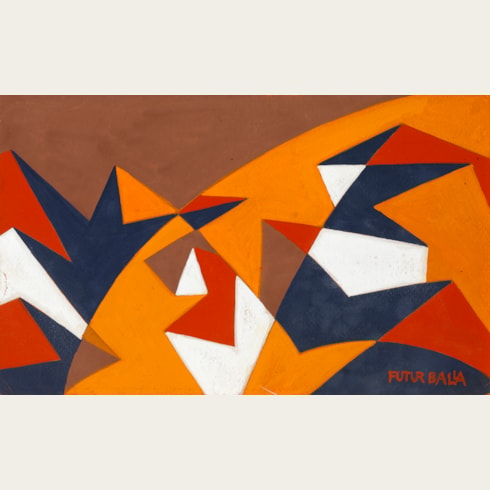Giacomo BALLA
(Turin 1871 - Rome 1958)
Sunset with Goldfish (Soleil couchant au poisson rouge-mer)
Sold
Pastel on coloured card.
Inscribed (by Benedetta Marinetti) 'Balla. Soleil au couchant / poisson rouge-mer / (pastel) / Cadeau de Balla a moi un / jour de l’année 1914, pendant que / j’etait dans son atelier avec la / peintre Rougena Zatkova. / Maintenant cette oeuvre appartient / a Mr. e Mrs. Harry L. Winston / Rome 1 giugno 1958 Benedetta Marinetti' on the reverse of the frame backing board.
248 x 375 mm. (9 3/4 x 14 3/4 in.)
ACQUIRED BY THE NATIONAL GALLERY OF CANADA, OTTAWA.
Inscribed (by Benedetta Marinetti) 'Balla. Soleil au couchant / poisson rouge-mer / (pastel) / Cadeau de Balla a moi un / jour de l’année 1914, pendant que / j’etait dans son atelier avec la / peintre Rougena Zatkova. / Maintenant cette oeuvre appartient / a Mr. e Mrs. Harry L. Winston / Rome 1 giugno 1958 Benedetta Marinetti' on the reverse of the frame backing board.
248 x 375 mm. (9 3/4 x 14 3/4 in.)
ACQUIRED BY THE NATIONAL GALLERY OF CANADA, OTTAWA.
This pastel drawing may be counted among Giacomo Balla’s abstract studies of velocity that occupied him from 1913 onwards; a period of intense creativity for the artist. The use of pastel was a characteristic of Balla’s drawings throughout this fertile period and, as Piero Pacini has noted, ‘Balla’s singular use of pastels [was] enriched by an array of dazzling, hazy, flashing light effects.’
This drawing may in particular be compared, on technical, stylistic and compositional grounds, with such works by Balla as a small pastel (present location unknown) and a study in coloured chalks entitled Speeding Automobile of 1913, in the Estorick Collection of Modern Italian Art in London. As Anne Coffin Hanson has noted of the present work, ‘The descriptive French title is unusual and may have been invented by Madame Marinetti, to whom Balla presented the work. On the other hand, it may indicate Balla’s enduring commitment to naturalistic observation as a basis for his studies of light and speed.’
The first owner of Sunset with Goldfish (Soleil couchant au poisson rouge-mer) was Benedetta Cappa Marinetti (1897-1977), known professionally as ‘Benedetta’. An artist and writer, Benedetta studied with Giacomo Balla in Rome, and became a part of the Futurist group. In 1923 she married Filippo Tomasso Marinetti, founder of the Futurist movement. According to her inscription on the backing board, Benedetta Cappa was given this pastel by Giacomo Balla in 1914, while she was still a student, when she was in the artist’s studio in the company of her fellow Futurist painter, the Czech artist Ružena Zátková.
The present sheet remained in Benedetta’s possession until the late 1950’s, when it was acquired from her by the American collectors Mr. and Mrs. Harry Lewis Winston, who became close friends of hers. Beginning in the 1930’s, Lydia Winston Malbin (1897-1989) assembled a significant collection of major European art, with a particular focus on the work of the Italian Futurist artists. She acquired several works by Balla, for, as she noted in an interview, ‘I wanted atypical as well as typical works of artists to show the various aspects of an artist's work...in order to understand Balla you had to know what he was doing.’
This drawing may in particular be compared, on technical, stylistic and compositional grounds, with such works by Balla as a small pastel (present location unknown) and a study in coloured chalks entitled Speeding Automobile of 1913, in the Estorick Collection of Modern Italian Art in London. As Anne Coffin Hanson has noted of the present work, ‘The descriptive French title is unusual and may have been invented by Madame Marinetti, to whom Balla presented the work. On the other hand, it may indicate Balla’s enduring commitment to naturalistic observation as a basis for his studies of light and speed.’
The first owner of Sunset with Goldfish (Soleil couchant au poisson rouge-mer) was Benedetta Cappa Marinetti (1897-1977), known professionally as ‘Benedetta’. An artist and writer, Benedetta studied with Giacomo Balla in Rome, and became a part of the Futurist group. In 1923 she married Filippo Tomasso Marinetti, founder of the Futurist movement. According to her inscription on the backing board, Benedetta Cappa was given this pastel by Giacomo Balla in 1914, while she was still a student, when she was in the artist’s studio in the company of her fellow Futurist painter, the Czech artist Ružena Zátková.
The present sheet remained in Benedetta’s possession until the late 1950’s, when it was acquired from her by the American collectors Mr. and Mrs. Harry Lewis Winston, who became close friends of hers. Beginning in the 1930’s, Lydia Winston Malbin (1897-1989) assembled a significant collection of major European art, with a particular focus on the work of the Italian Futurist artists. She acquired several works by Balla, for, as she noted in an interview, ‘I wanted atypical as well as typical works of artists to show the various aspects of an artist's work...in order to understand Balla you had to know what he was doing.’
A leading member of the Futurist movement in Italy, Giacomo Balla received almost no formal artistic training. Following the death of his father when he was aged just nine, he served an apprenticeship in a lithography shop, while at the same time taking drawing classes in the evenings. He also spent a few months at the Accademia Albertina in Turin. He showed some early promise as a portraitist, and also produced paintings which display an interest in social issues. By the end of the first decade of the 20th century he was painting in a quasi-Divisionist style, resulting in such dramatic paintings as Street Light of 1909, today in the Museum of Modern Art in New York.
The following year Balla was one of the signatories of the first Futurist artistic manifesto, the Manifesto dei pittori futuristi, and began to take an active role in the group founded by the theorist Filippo Tommaso Marinetti. He first exhibited with the Futurists in 1912. The following year he sold all of his early paintings at auction, and devoted himself wholeheartedly to the new Futurist aesthetic. In 1914 several of his paintings were reproduced in Umberto Boccioni’s Pittura, scultura futuriste (Dinamismo plastico). Balla’s paintings, with their emphasis on lines of ‘speed’ or ‘force’, continued to exemplify the Futurist ideal in the years of the First World War and afterwards. During the second wave of Futurism in the 1920’s, he remained one of the only artists of the first generation of Futurist painters to continue to express some of the same concerns as his younger contemporaries, with a growing interest in geometric forms. By the early 1930’s, however, Balla had reverted to his early realism in landscape paintings and portraiture, including a series of introspective self-portraits.
Provenance
Presented by the artist to Benedetta Cappa Marinetti, Rome, in c.1914
Acquired from her in 1958 by Lydia Winston (later Mrs. Barnett Malbin) and Harry Lewis Winston, Detroit, New York and Birmingham, Michigan
Lydia Winston Malbin, New York
Her sale, New York, Sotheby’s, 16 May 1990, lot 11
Jan Krugier and Marie-Anne Poniatowski, Geneva.
Literature
New York, Solomon R. Guggenheim Museum, Futurism: A Modern Focus. The Lydia and Harry Lewis Winston Collection (Dr. and Mrs. Barnett Malbin), exhibition catalogue, 1973, p.51, no.16; Anne Coffin Hanson, The Futurist Imagination: Word + Image in Italian Futurist Painting, Drawing, Collage and Free-Word Poetry, exhibition catalogue, New Haven, 1983, p.78, no.4, illustrated in colour pl.1; Alexander Dückers, ed., Linie, Licht und Schatten: Meisterzeichnungen und Skulpturen der Sammlung Jan und Marie-Anne Krugier-Poniatowski, exhibition catalogue, Berlin, 1999, pp.306-307, no.145; Tomàs Llorens, ed., Miradas sin tiempo: Dibujos, Pinturas y Esculturas de la Colección Jan y Marie-Anne Krugier-Poniatowski, exhibition catalogue, Madrid, 2000, pp.354-355, no.161 (entry by Anita Beloubek-Hammer); Philip Rylands, ed., The Timeless Eye: Master Drawings from the Jan and Marie-Anne Krugier-Poniatowski Collection, exhibition catalogue, Venice, 1999, p.395.







